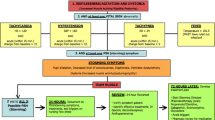Abstract
The activity of the sympathetic nervous system during the course of severe closed head injury has been evaluated in 15 patients by measuring plasma levels of epinephrine and norepinephrine. With the onset of the transition stage from midbrain syndrome to the apallic syndrome the plasma levels mainly of norepinephrine started to increase and remained high during the further course of the disease. During the remission from the apallic syndrome the elevated norepinephrine levels started to decline. The data indicate that a longlasting overactivity of the sympathetic nervous system is a characteristic feature in the course of severe head injury.
As a rational therapy to protect the peripheral tissues against the consequences of a longlasting sympathetic overactivity we suggest the use of β-adrenergic blocking agents and adrenergic neuron blocking drugs.
Similar content being viewed by others
References
Avenarius HJ, Gerstenbrand F (1977) The transition stage from midbrain syndrome to traumatic apallic syndrome. In: Dalle Ore G, Gerstenbrand F, Lücking CH, Peters G, Peters UH (eds) The Apallic Syndrome. Psychiatry series 14. Springer, Berlin Heidelberg New York, pp. 22–25
Batstone GF, Alberti KGMM, Hinks L, Smythe P, Laing JE, Ward CM, Ely DW, Bloom SR (1976) Metabolic studies in subjects following thermal injury. Intermediary metabolites, hormones and tissue oxygenation. Burns 2:207
Burch GE, Meyers R, Abildskov JA (1954) A new electrocardiographic pattern observed in cerebrovascular accidents. Circulation 9:719
Burch GE, Colcolough H, Giles T (1970) Intracranial lesions and the heart. Am Heart J 80:574
Cameron SJ, Doig A (1970) Cerebellar tumors presenting with clinical features of phaeochromocytoma. Lancet 1:492
Carruthers ME, Taggert P, Salpekar PD, Gatt JA (1976) Some metabolic effects of β-blockade on temperature regulation and in the presence of trauma. In: Schweizer W (ed) Beta-blockers: present status and future prospects. Huber, Bern, pp. 259–268
Cheng TO, Bashour TT (1976) Striking electrocardiographic changes associated with paeochromocytoma. Masquerading as ischemic heart disease. Chest 70:397
Connor RCR (1968) Heart damage associated with intracranial lesions. Br Med J 3:29
Cushing H (1902) Some experimental and clinical observations concerning states of intracranial tension. Am J Med Sci 124:375
Estanol BV, Marin OSM (1975) Cardiac arrhythmias and sudden death in subarachnoid haemorrhage. Stroke 6:382
Evans CH, Westfall V, Atuk N (1972) Astrocytoma mimicking the feature of phaeochromocytoma. N Engl J Med 289:1397
Falsetti HL, Moody RA (1966) Electrocardiographic changes in head injuries. Dis Chest 49:420
Fentz V, Gormsen J (1962) Electrocardiographic patterns in patients with cerebrovascular accidents. Circulation 25:22
Gerstenbrand F (1977) The symptomatology of the apallic syndrome. In: Dalle-Ore G, Gerstenbrand F, Lücking CH, Peters G, Peters UH (eds) The Apallic Syndrome. Psychiatry Series 14. Springer, Berlin Heidelberg New York, pp. 14–21
Gerstenbrand F, Lücking CH (1970) Die akuten traumatischen Hirnstammschäden. Arch Psychiat Nervenkr 213:264
Gobiet W, Werner U, Hackenberg K (1976) Verlaufsuntersuchungen zum Verhalten der Hormone des Hypophysenvorderlappens, der Nebennieren sowie der biogenen Amine nach schwerem Schädel-Hirn-Trauma. In: Schmidt K, Pottoff PC (eds) Neurogener Schock. Schattauer, Stuttgart, pp. 91–98
Goldman MR, Rogers EL, Rogers MC (1975) Subarachnoid haemorrhage: Association with unusual electrocardiographic changes. Jama 234:957
Haider W, Lackner F, Schlick W, Benzer H, Gerstenbrand F, Irsigler K, Korn A, Krystof G, Mayrhofer O (1975) Metabolic changes in the course of severe acute brain damage. Eur J Intens Care Med 1:19
Haider W, Benzer H, Krystof G, Lackner F, Mayrhofer O, Steinbereithner K, Irsigler K, Korn A, Schlick W, Binder H, Gerstenbrand F (1975) Urinary catecholamine excretion and thyroid hormone blood level in the course of severe acute brain damage. Eur J Intens Care Med 1:115
Hersch C (1961) Electrocardiographic changes in head injuries. Circulation 23:853
Hersch C (1964) Electrocardiographic changes in subarachnoid haemorrhage, meningitis and intracranial spaceoccupying lesions. Br Heart J 26:785
Hörtnagl H, Benedict CR, Grahame-Smith DG, McGrath B (1977) A sensitive radioenzymatic assay for adrenaline and noradrenaline in plasma. Br J Clin Pharmacol 4:553
Ingvar DH, Brun A (1972) Das komplette apallische Syndrom. Arch. Psychiat Nervenkr 215:219
Jäätelä A, Alko A, Avikainen Y, Karaharju E, Kataja J, Lakdensun M, Lepistö P, Rokkanen P, Tervo T (1975) Plasma catecholamines in severely injured patients: a prospective study on 45 patients with multiple injuries. Br J Surg 62:177
Lake CR, Ziegler MC, Kopin IJ (1976) Use of plasma catecholamine for evaluation of sympathetic neuronal function. Life Sci 18:1315
Landsberg L, Young JB (1978) Fasting, feeding and regulation of the sympathetic nervous system. N Engl J Med 298:1295
Mazey RM, Kotchen TA, Ernst CB (1974) A syndrome resembling phaeochromocytoma following a stroke. Jama 230:575
McNealy De, Plum F (1962) Brainstem dysfunction with supratentorial mass lesions. Arch Neurol 7:16
Menon IS (1964) Electrocardiographic changes simulating myocardial infarction in cerebrovascular accident. Lancet 2:433
Miller R, Stark DCC, Gitlow SE (1976) Paroxysmal hyperadrenergic state. A case during surgery for intracranial aneurysm. Anaesthesia 31:743
Nathan MA, Reis DJ (1975) Fulminating arterial hypertension with pulmonary edema from release of adreno-medullary catecholamines after lesions of the anterior hypothalamus in the rat. Circ Res 37:226
Pedersen EB, Christensen NJ (1975) Catecholamines in plasma and urine in patients with essential hypertension determined by double-isotope derivative technique. Acta Med Scand 198:373
Plum F, Posner JB (1966) Diagnosis of Stupor and Coma. First edition. F. A. Davis Company, Philadelphia
Reichenbach DD, Benditt ED (1970) Catecholamine and cardiomyopathy: The pathogenesis and potential importance of myofibrillar degeneration. Human Pathol 1:125
Sayer WJ, Moser M, Mattingly TW (1954) Phaeochromocytoma and the abnormal electrocardiogram. Am Heart J 48:42
Schuster S (1960) Electrocardiogram in subarachnoid haemorrhage. Br Heart J 22:316
Srivastavo SC, Robson AO (1964) Electrocardiographic abnormalities associated with subarachnoid haemorrhage. Lancet 2:431
Wilmore DW, Long JM, Mason AD, Shreen RW, Pruitt BA (1974) Catecholamines: Mediator of the hypermetabolic response to thermal injury. Ann Surg 180:653
Young JB, Landsberg L (1977) Stimulation of the sympathetic nervous system during sucrose feeding. Nature 269:615
Author information
Authors and Affiliations
Rights and permissions
About this article
Cite this article
Hörtnagl, H., Hammerle, A.F., Hackl, J.M. et al. The activity of the sympathetic nervous system following severe head injury. Intensive Care Med 6, 169–177 (1980). https://doi.org/10.1007/BF01757299
Issue Date:
DOI: https://doi.org/10.1007/BF01757299




